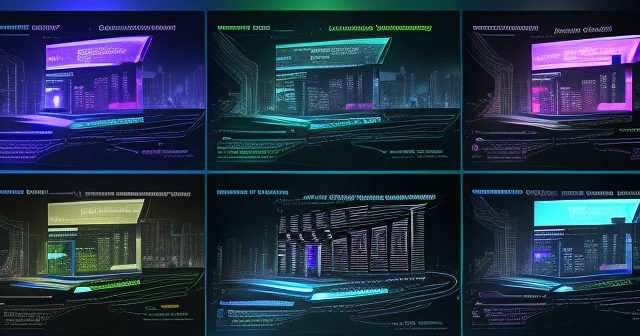Understanding Advanced Micro Devices (AMD) in Today’s Dynamic Market
Welcome, aspiring investors and seasoned traders! We’re here to navigate the complex world of semiconductor stocks, specifically focusing on Advanced Micro Devices, or AMD. This company is a titan in the industry, constantly innovating and competing across critical technology sectors like personal computing, servers, and the burgeoning field of artificial intelligence. Its products, from powerful Ryzen CPUs in your home computer to the muscle behind data centers with Epyc processors and cutting-edge AI accelerators, touch many facets of modern digital life.
Given AMD’s pivotal role and the volatile nature of the tech market, one question frequently arises for investors: Is AMD stock currently undervalued? This isn’t a simple ‘yes’ or ‘no’ query. Like solving a complex puzzle, we need to examine various pieces of information – from market share battles and competitive pressures to financial performance and different valuation metrics – to form a well-rounded perspective. Think of us as your guide, helping you piece together the insights needed to understand AMD’s position and the factors influencing its potential worth in the market today.

To enhance our understanding of AMD and its market position, let’s consider some key points:
- AMD’s innovative products play a crucial role in multiple technology sectors.
- The semiconductor market is both dynamic and competitive, requiring constant innovation.
- Understanding various valuation metrics is essential for informed investment decisions.
AMD’s Strong Foothold: Capturing CPU Market Share from Intel
One of AMD’s most significant achievements in recent years has been its success in chipping away at the long-held dominance of Intel in the CPU market. For decades, Intel was the undisputed leader, but AMD, under the leadership of CEO Lisa Su, has launched compelling products like the Ryzen line for personal computers and the Epyc line for servers. We’ve seen consistent reports indicating that AMD has successfully gained market share from Intel in both these crucial segments. This isn’t just about bragging rights; gaining market share directly impacts revenue and profitability, signaling strong product competitiveness and execution.
This shift hasn’t happened by accident. AMD’s strategic focus on delivering competitive performance and value, often leveraging advanced manufacturing process nodes through partners like TSMC, has resonated with consumers and enterprise clients alike. While Intel faces its own operational challenges and roadmap hurdles, AMD has capitalized effectively. Understanding this dynamic is key because a company that is successfully taking share from a larger competitor demonstrates underlying strength and potential for continued growth in its core businesses. It shows they are executing well on product development and market strategy, building a solid foundation even as they pursue newer, higher-growth areas.

Strategic Acquisitions: Expanding AMD’s Data Center Capabilities
Beyond organic growth in CPUs and GPUs, AMD has significantly bolstered its capabilities and market presence through strategic acquisitions. Think of these acquisitions as adding specialized tools and talent to AMD’s toolbox, specifically geared towards strengthening its position in the high-growth data center segment. Two notable examples are the acquisitions of Xilinx and Pensando Systems. Xilinx brought expertise in FPGAs (Field-Programmable Gate Arrays) and adaptive computing, which are increasingly vital for accelerated computing and networking in data centers. Pensando Systems added programmable packet processors and security technology, further enhancing AMD’s ability to offer comprehensive solutions for data center infrastructure.
More recently, collaborations or acquisitions like Silo AI (focused on AI software capabilities) and ZT Systems (a provider of rack-level solutions) highlight AMD’s efforts to move beyond just providing chips. These moves are designed to allow AMD to offer more integrated, higher-value solutions to hyperscalers and enterprise customers building out their data center infrastructure, particularly for demanding workloads like AI and networking. These strategic additions demonstrate AMD’s commitment to expanding its footprint and capabilities, positioning itself as a more complete player in the data center ecosystem and laying the groundwork for future revenue streams beyond traditional CPU sales.

The Centerpiece: AMD’s Ambition in the AI Accelerator Market
Perhaps the most talked-about aspect of AMD’s future revolves around its ambition in the AI accelerator market. This is where the company aims to challenge the current leader and capture a significant portion of the massive spending on artificial intelligence infrastructure, particularly within large data centers operated by cloud providers and tech giants (often called hyperscalers). AMD’s primary offering in this space is its Instinct line of GPUs, such as the MI325X and upcoming generations. These are specifically designed to handle the intense computational demands of training and running AI models.
AMD has outlined an aggressive roadmap for its Instinct accelerators, including a commitment to an annual product cadence. This means they plan to release new, more powerful generations of their AI chips every year, aiming to keep pace with the rapid advancements in AI technology and competitor offerings. Their strategy involves leveraging their chip design expertise and manufacturing partnerships to deliver competitive performance and build out a software ecosystem that makes it easier for developers and customers to deploy AI workloads on AMD hardware. This segment represents a critical growth vector for AMD, offering the potential for substantial revenue if they can successfully execute their plans and gain traction in this highly competitive space.

Navigating the AI Landscape: AMD’s Challenge Against Nvidia’s Dominance
While AMD has clear ambitions in AI, we must acknowledge the reality of the current market landscape: it is overwhelmingly dominated by Nvidia. Nvidia not only holds a commanding lead in AI GPU hardware but also possesses a significant competitive moat through its CUDA software platform, which is deeply embedded in the AI development community. This software ecosystem makes it incredibly convenient for developers to work with Nvidia GPUs, creating a powerful network effect that is difficult for competitors to overcome. Nvidia’s growth trajectory in the AI data center segment has been nothing short of exponential, setting a very high bar for any challenger.
AMD’s challenge isn’t just about building fast hardware; it’s also about building a compelling software story and persuading customers to diversify their AI hardware suppliers. While AMD’s Instinct GPUs show promise and the company is investing heavily in its software stack (like ROCm), they are currently far behind Nvidia’s established lead and the sheer scale of their deployments. Understanding this competitive dynamic is crucial for any investor. AMD is playing catch-up in a market segment that is experiencing explosive growth, but where one player holds a very strong, perhaps even defining, advantage. This competitive pressure is a key factor when evaluating AMD’s future revenue potential and overall investment risk.
Analyzing Recent Financial Performance: Q4 2024 Insights and Future Forecasts
Let’s turn our attention to the numbers. When assessing whether a stock like AMD is undervalued, we must look at its recent financial performance and what the company is forecasting for the future. AMD’s Q4 2024 financial results provided some encouraging signs, with both revenue and earnings beating analyst expectations. This performance was reportedly driven by strength in its core PC and server segments, reflecting the market share gains we discussed earlier. A quarterly beat is generally positive news, indicating solid execution in the recent past.
However, the picture became slightly more complex when AMD provided its forecast, particularly regarding the AI data center business. While the company expects significant long-term growth in AI GPU revenue, their forecast for the first half of 2025 was weaker than some analysts and investors had anticipated. This tempered enthusiasm, suggesting that while AMD is making progress in AI, the near-term ramp-up in sales might not be as steep or immediate as Nvidia’s trajectory. This mixed financial outlook – a beat on past performance but a more cautious near-term forecast in the critical AI segment – contributes to the complexity of the stock’s current situation and the ongoing debate about its valuation.

The Valuation Puzzle: Contrasting Views on AMD’s Fair Value
Now, let’s tackle the core question from a valuation perspective. Is AMD undervalued? The answer depends heavily on who you ask and which metrics you prioritize. Fundamental analysts often use models to determine a “fair value estimate” for a stock based on expected future earnings, growth rates, risks, and other factors. One notable source, Morningstar, recently assessed AMD with a 4-star rating, which they interpret as suggesting the stock is currently undervalued. Their Fair Value Estimate (FVE) for AMD stood at $140 based on data available around February 2025.
It’s important to note that Morningstar actually lowered their FVE from a previous level, indicating slightly reduced optimism about the pace of AI GPU growth compared to earlier expectations. Nevertheless, their assessment still pointed towards undervaluation relative to the market price at that time, based on their long-term projections, particularly for AMD’s potential in the AI space. However, valuation is subjective. Other analysts may arrive at different conclusions based on different assumptions or methodologies. This contrasting perspective – a fundamental case for undervaluation from one source versus the market’s current trading price – highlights the ongoing debate surrounding AMD’s true worth.
Technical Signals: What Chart Indicators Tell Us About AMD Stock’s Current State
While fundamental analysis looks at a company’s intrinsic value, technical analysis examines stock price movements, volume, and indicators to identify trends and potential buy/sell signals. For investors who incorporate technical analysis into their decisions, the picture for AMD stock recently presented a cautionary tale. According to data from Investors.com, AMD stock was not flashing a “buy signal” at a particular point in time, trading below its 200-day moving average. The 200-day moving average is a widely watched indicator; trading below it often suggests a stock is in a longer-term downtrend or consolidation phase, typically not a favorable sign for initiating new positions based purely on technical momentum.
Furthermore, key technical ratings published by Investor’s Business Daily (IBD) were reportedly low. For instance, the IBD Composite Rating, which combines various technical and fundamental factors, was relatively low (e.g., 66). The Relative Strength (RS) Rating, which measures a stock’s price performance compared to other stocks, was notably low (e.g., 15), indicating significant underperformance relative to the broader market. The Accumulation/Distribution Rating (e.g., C) suggested neutral to moderate selling pressure. These technical indicators provide a very different perspective from a fundamental valuation assessment, signaling that based purely on price action and related metrics, the stock was not in a strong position for an immediate technical buy, irrespective of any potential underlying undervaluation.

The Erosion of Moats: Examining AMD’s Competitive Advantages and Vulnerabilities
Understanding a company’s economic moat – its sustainable competitive advantage – is critical for assessing its long-term investment potential. Morningstar assesses AMD as having a Narrow Economic Moat. This moat is primarily based on intangible assets, specifically AMD’s chip designs and the complex intellectual property involved in developing high-performance CPUs and GPUs. Historically, a key aspect of AMD’s moat also derived from its cross-licensing agreement with Intel for the x86 architecture, essentially giving them a duopoly in the PC and server CPU space.
However, this x86 license moat is increasingly seen as potentially eroding over time. Why? Because the computing landscape is evolving. The rise of the ARM architecture, particularly its success in mobile and more recently with Apple Silicon in PCs, demonstrates that alternative architectures can compete, potentially reducing the long-term reliance on x86. Furthermore, large cloud providers (hyperscalers) are increasingly designing their own chips (like Google’s TPUs or Amazon’s Trainium/Inferentia) for specific workloads, including AI. While AMD’s design expertise remains a significant asset, the nature of the competitive landscape is shifting, potentially challenging the long-term durability of its traditional advantages. This erosion of moats introduces vulnerability that investors must consider alongside the company’s growth prospects.
Understanding the Risks: Competition, Geopolitics, and Internal Challenges
Investing in the semiconductor industry, especially in a company like AMD, involves navigating significant risks. We’ve already touched upon the intense competition, particularly from Nvidia in AI, where Nvidia’s strong software ecosystem represents a formidable moat that AMD needs to overcome. The threat of hyperscalers developing their own silicon is another structural risk, potentially reducing demand for off-the-shelf AI accelerators or CPUs from companies like AMD.
Geopolitical factors also play a substantial role. Trade tensions and export restrictions, particularly those impacting the Chinese market, pose an ongoing risk for semiconductor companies. China is a massive market for servers and other computing hardware, and restrictions can limit AMD’s ability to sell its high-end products there, impacting revenue. Additionally, AMD, like many fabless semiconductor companies, relies heavily on third-party manufacturers, primarily TSMC, for producing its advanced chips. Any disruptions at these fabs (due to geopolitical issues, natural disasters, or capacity constraints) could impact AMD’s supply chain and product availability. Finally, Morningstar assigns a High Uncertainty Rating to AMD, reflecting the inherent volatility and difficulty in predicting outcomes in this fast-moving industry, particularly concerning the pace of AI adoption and competitive shifts.
Analyst Consensus and Investor Sentiment: Reading the Room on AMD
When evaluating a stock, it’s also helpful to gauge the broader market sentiment and what Wall Street analysts are recommending. According to TipRanks, the Wall Street analyst consensus for AMD has been a “Moderate Buy.” This consensus rating is derived from the recommendations of various analysts covering the stock, blending Buy, Hold, and Sell ratings into an overall view. While a Moderate Buy suggests a generally positive outlook, it’s not as strong as a “Strong Buy,” indicating some level of caution or mixed views among the analyst community.
The average price target from these analysts suggests a modest upside potential from the stock’s trading price at the time of the data. While some analysts may have very bullish price targets, others might be more conservative, pulling the average down. Furthermore, the TipRanks data noted that despite some individual investor views suggesting the stock might have bottomed earlier in the year (e.g., in April) and presented an opportunity, the market’s overall lack of confidence might be reflected in the stock’s performance relative to peers or its technical ratings. This blend of a Moderate Buy consensus with modest price target upside and observed cautious market sentiment paints a picture of a stock where expectations are positive but potentially tempered by the competitive and execution challenges ahead, especially in the AI space.
Conclusion: Is AMD Undervalued? Synthesizing the Evidence for Investors
So, after examining the various facets of Advanced Micro Devices – its market share gains, strategic acquisitions, ambitious AI plans, competitive challenges, financial performance, valuation perspectives, technical signals, inherent risks, and market sentiment – where do we land on the question: Is AMD undervalued?
The evidence presents a complex and somewhat conflicting picture. Fundamentally, sources like Morningstar make a case for undervaluation based on AMD’s long-term growth potential, particularly if it successfully captures a significant portion of the AI market, despite the near-term AI forecast being weaker than some hoped. AMD has demonstrated strong execution in its core CPU business, successfully taking market share, which provides a solid foundation.
However, this potential must be weighed against significant challenges and risks. The competitive landscape, dominated by Nvidia in AI, is fierce, and overcoming Nvidia’s software moat is a major hurdle. The erosion of the traditional x86 moat introduces long-term uncertainty. Furthermore, technical analysis signals have recently suggested the stock is not in a favorable position from a momentum standpoint. Geopolitical risks and the reliance on manufacturing partners add layers of potential disruption.
For you, the investor, deciding whether AMD is undervalued depends largely on your perspective, time horizon, and risk tolerance. If you believe in AMD’s ability to execute its AI roadmap effectively, gain meaningful share against Nvidia over the long term, and continue leveraging its strengths in CPUs and data center solutions, you might see the current price as an attractive entry point, aligning with the fundamental ‘undervalued’ view. However, if you are more risk-averse, prioritize strong technical indicators, or are concerned about the intense competition and market execution risks, you might view the stock as fairly valued or even potentially facing headwinds, despite its long-term prospects.
Ultimately, investing in AMD requires a careful balancing act, acknowledging its significant achievements and potential while remaining realistic about the substantial challenges and uncertainties inherent in the fast-evolving semiconductor industry. It’s an investment case that demands thorough research and alignment with your personal investment strategy.
| Key Metrics | Q4 2024 Results | Forecast H1 2025 |
|---|---|---|
| Revenue | Exceeded Analyst Expectations | Weaker than Expected |
| Earnings | Beating Analyst Estimates | Temper Enthusiasm |
| Market Share Gains | Strong in PC and Server Segments | Long-term Growth in AI Expected |
FAQs
Q:Is AMD currently undervalued compared to its competitors?
A:Some analysts believe AMD is undervalued based on fundamentals, while others highlight risks that may affect its future valuation.
Q:What challenges does AMD face in the AI sector?
A:AMD faces significant competition from Nvidia, which has a strong foothold in the AI market due to its established software ecosystem.
Q:How does AMD’s recent performance impact its market perception?
A:AMD’s recent performance shows resilience, but mixed forecasts create uncertainty about its AI segment growth in the short term.

留言